Last May, I had the eye-opening opportunity to travel to several regions of Norway. As a climate scientist studying sea-level changes in Singapore, I was looking forward to developing new collaborations with Norwegian scientists. What I was perhaps less expecting was to see firsthand some direct impacts climate change has on the local communities. Jointly supported by the Earth Observatory of Singapore (EOS) and the Centre of Climate Research Singapore (CCRS), this trip will remain unforgettable and inspiring for a long time.

Bird’s eye view of Svalbard from the plane. Svalbard is known as the ‘Arctic Desert’ because of its extreme climate. As Svalbard is north of the Arctic Circle, it experiences midnight sun in the summer (24 hours of sunlight) and polar night in the winter (24 hours of darkness) (Source: Trina Ng/Earth Observatory of Singapore)
During Arctic Frontiers 2022, a conference that brought together politicians, scientists, and the indigenous community to exchange knowledge about the Arctic, I learnt that many communities in the north, such as the Svalbard population, are already adapting to climate change on a daily basis. For them, climate change is not necessarily an immediate threat to livelihood. The loss of sea ice, for example, extends the fishing season for Greenlandic communities. In turn, this makes year-round shipping possible, and gives more opportunities for tourists. But what is providing an immediate gain will likely have environmental implications in the long run. For example, overfishing could occur, and the influx of tourists could put a strain on local resources.
I look at long-term effects of climate change as part of my PhD research, which involves producing sea-level projections for Singapore and communicating them to stakeholders. Unlike the Arctic where communities are already feeling strong impacts of climate change, Singapore will mostly experience long-drawn effects of climate change because of delayed responses of the Earth’s system.
 Ms Trina Ng, PhD candidate at EOS, during her trip to Norway (Source: Trina Ng/Earth Observatory of Singapore)
Ms Trina Ng, PhD candidate at EOS, during her trip to Norway (Source: Trina Ng/Earth Observatory of Singapore)
While witnessing the short-term impacts of climate change firsthand, I also looked at my research with a new perspective.
When I arrived at the Kongsberg Satellite Station, which is the world’s largest ground station support for polar orbiting satellites, I saw structures that looked like massive golf balls littering the vast plateaus against a backdrop of cloudless blue skies and glaciers. These structures are carefully designed to shield the ground receivers from the harsh, extreme environment in Svalbard. I spend my days modelling sea levels on my computer, so I felt refreshed by this field excursion and by the novelty of such a satellite station. This gave me a more holistic outlook on my research.
 Kongsberg Satellite Station (KSAT) at Longyearbyen, Svalbard (Source: Trina Ng/Earth Observatory of Singapore)
Kongsberg Satellite Station (KSAT) at Longyearbyen, Svalbard (Source: Trina Ng/Earth Observatory of Singapore)
I gained other perspectives on my research during my subsequent trip to Bergen to work with Dr Kristin Richter from the Norwegian Research Centre. We shared about how we produce sea-level projections, which gave me new ideas about how I can improve my methodology to better estimate these projections for Singapore.
My favourite part of this trip will remain the one-night stay in Longyearbyen, Svalbard. Known as the High Arctic, Svalbard is located 74 to 81 degrees north in the Arctic Circle— this would be the furthest north I have ever been (and will ever be)! As a junior research scientist at CCRS and PhD candidate at EOS, I felt very privileged to have such an opportunity during the early stages of my career.
 The research team walking to the University of Svalbard, which is located near the coast and facing the Greenland Sea (Source: Trina Ng/Earth Observatory of Singapore)
The research team walking to the University of Svalbard, which is located near the coast and facing the Greenland Sea (Source: Trina Ng/Earth Observatory of Singapore)
A different version of this post was published in the October issue of the CCRS newsletter.
Ms Trina Ng was part of the EOS research team who travelled to Norway to better assess the impacts of the changing polar region on Singapore and Singapore. This trip is featured in the Polar Impact Asia documentary, that you can watch here.